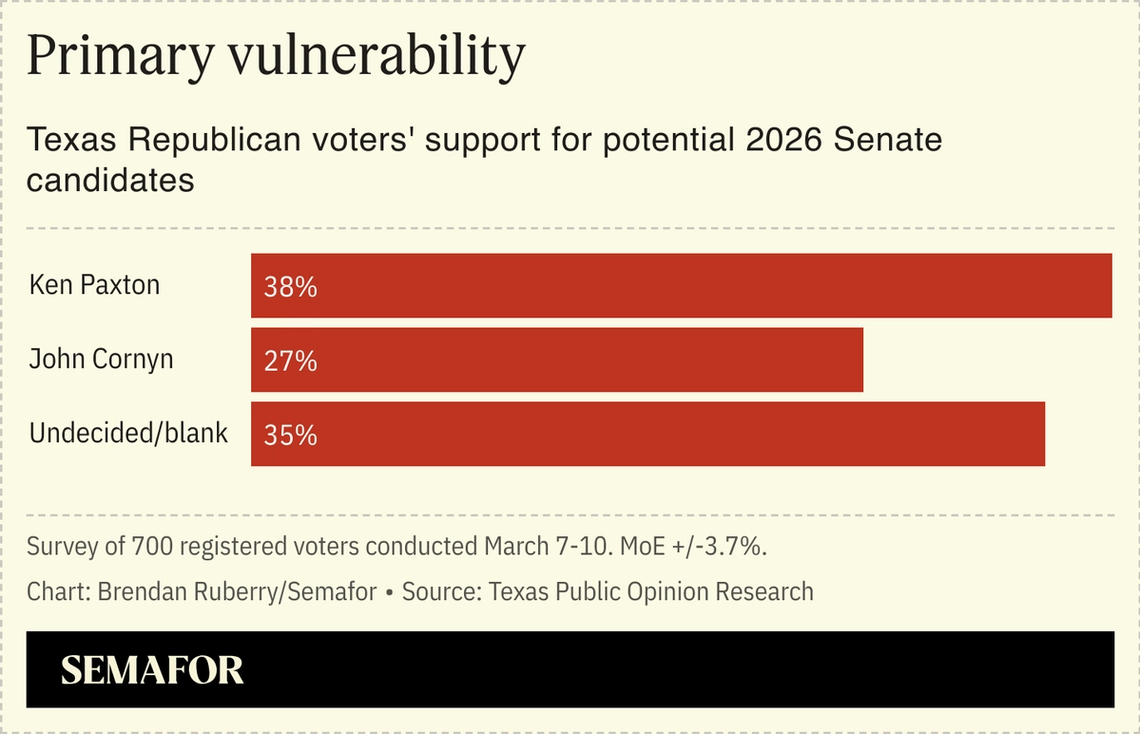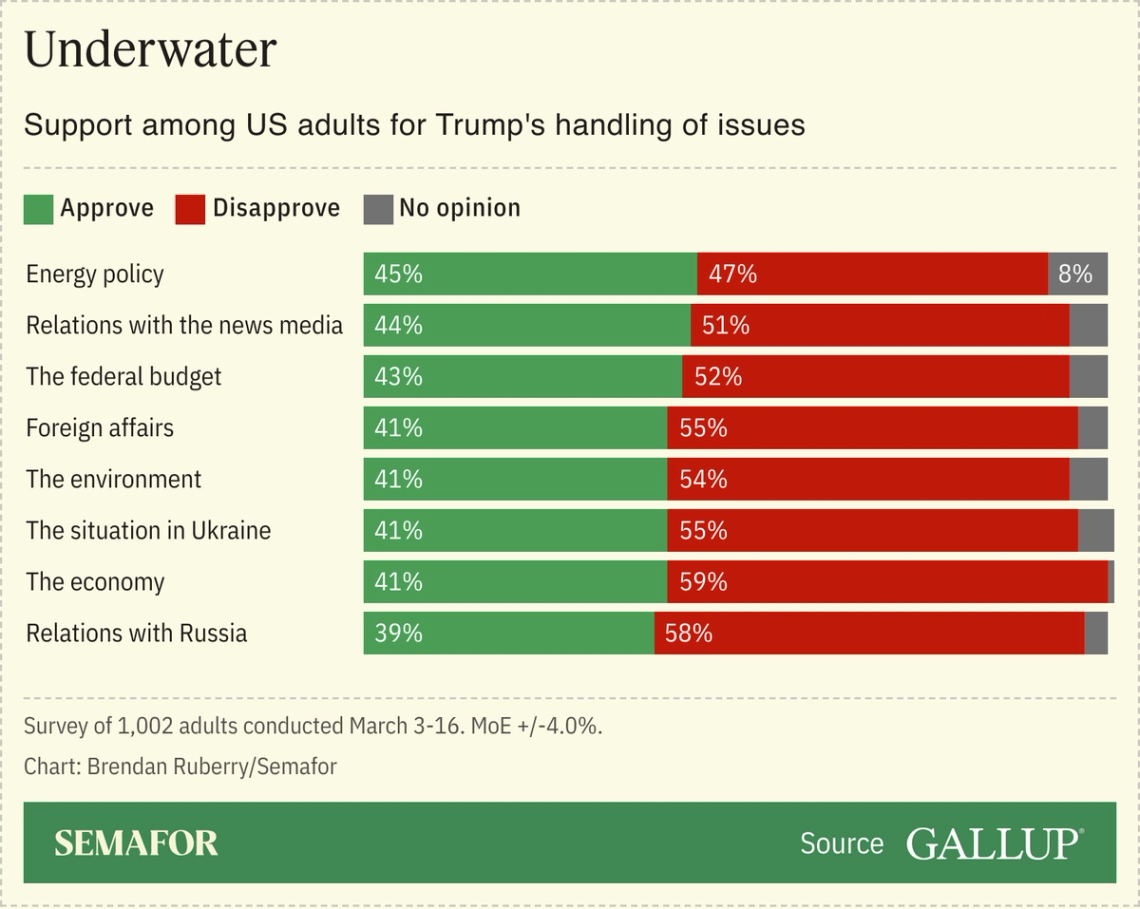 Polls Three months out from primary day, New York Mayor Eric Adams’ reelection bid is more or less over. Wounded by scandal, then by the DOJ deal that ended the investigation into his finances and donations, he now has an 18% job approval rating in the city — nine points behind Donald Trump. That’s been a massive boost to Andrew Cuomo, who’s now the first choice of most Black voters and voters without college degrees. Zohran Mamdani, a democratic socialist who’s dominated fundraising and social media interest in the campaign so far, has consolidated the left-wing vote and surged with voters who have college degrees. There’s a sprawling liberal/left effort to stop Cuomo, but the instant runoff system, right now, helps him: When the weaker non-Cuomo candidates are disqualified, Cuomo beats Mamdani by a 2-1 margin.  Republicans have gained ground in Texas since 2020, as Latino and other non-white voters shifted right. Texas Sen. John Cornyn has never been particularly vulnerable in a primary or general election, since winning his seat 23 years ago. But Democrats are wondering if his less-than-total loyalty to Donald Trump might make Cornyn vulnerable to a candidate easier to run against — Attorney Gen. Paxton, who led one of Trump’s 2020 election lawsuits and survived an impeachment effort backed by members of his own party. “You’ve constantly turned your back on Texans and President Trump,” Paxton posted on X in a reply to Cornyn’s campaign launch video, which reintroduced him as an ally who powered some of Trump’s “biggest wins.” (Cornyn was skeptical of the 2024 Trump comeback run, and didn’t endorse the president until he won the New Hampshire primary.) Former Rep. Colin Allred, who lost to Sen. Ted Cruz last year, is being encouraged to run again, and has a 37-30 favorable rating here. “Cornyn doesn’t have a base,” pollster Celinda Lake told Semafor. “He’s net negative with everybody.”  The paradox of Trump’s second term continues: His overall ratings are higher than they got in his first term, even as support for his handling of the economy is lower than it ever got then. Trump’s 45% approval rating is tracking ahead of his support eight years ago, bolstered by better numbers with non-white voters. Opinion of his handling of the economy and trade is much lower, with less than a third of independents expressing support. He hit lower levels on “foreign affairs” in the first term, and on the federal budget, when his administration added trillions to the debt with tax cuts and COVID relief bills. But right now, he’s only above water on energy policy, with gas prices falling slightly since January, and not to the $2 pandemic price that the Trump 2024 campaign suggested he could get back to. Ads Mike Verveer for Madison/Facebook Mike Verveer for Madison/Facebook- Mike Verveer for Madison, “Pandamonium.” On April 1, Wisconsinites will vote in the most expensive state supreme court race in American history. Tens of millions of dollars have been spent on ads, howling at viewers about child sex predators and rape, accompanied to menacing music and imagery. It’s also election day in a number of state municipalities, and Verveer, a Democrat running for another term on the Madison common council, is trying to take advantage of the grisly ad wars with this antidote: Thirty seconds of him and a man in a panda costume talking about his progressive urban growth agenda.
- Republican State Leadership Committee, “Show Up.” As we wrote last week, the crime-focused ads in Wisconsin have been joined by a new Republican argument: Show up to support Donald Trump. The closing message from the GOP’s downballot campaign group is that letting Democrats hold their court majority “would be like if Trump never won,” a nightmare dramatized by images of transgender athletes and chaos at the border. To save America and Wisconsin, voters can support “Trump ally Brad Schimel.”
- Building America’s Future, “Sneak.” Musk’s super PAC isn’t just spending in Wisconsin. It’s been running ads that thank Trump for his work so far, and give Republicans some air cover over obscure issues. This one, running in Kentucky, warns that the 340B drug pricing program, a target of the pharmaceutical industry, is funding “healthcare for illegal aliens,” abortion, and gender surgery — largely a reference to how some Planned Parenthood clinics take advantage of the pricing fix. It positions a low-profile issue that conservative think tanks and lobbyists have struggled to get into the news as a threat to Trump that Republicans must end.
Scooped!I talk to California Rep. Ro Khanna fairly frequently. Go back up to the Tesla story, earlier in this newsletter — he’s in there. But I must credit Shane Goldmacher at The New York Times for talking to Khanna after he decided to hold events in Ohio and at Yale Law School to campaign against Vice President JD Vance, because he doesn’t think his party is doing enough to define or debate the heir apparent to the presidency. This is an early and potentially important 2028 story, even if Khanna doesn’t end up running. Few Democrats focus on Vance right now, even as they plot out New Hampshire trips, and Goldmacher got there first. Next - Four days until Wisconsin’s state supreme court election
- 74 days until primaries in New Jersey
- 81 days until primaries in Virginia
- 88 days until primaries in New York City
- 221 days until off-year elections
- 584 days until the 2026 midterm elections
David RecommendsWe’re enjoying a solid month for serious political books. You should read “Abundance,” if you’re going to be participating in any Democratic Party discourse through 2028; you should read “Revenge” to get started on the cannonade of 2024 campaign lookbacks coming all year. But I had a lot of fun with something completely different, Alan Siegel’s “Stupid TV, Be More Funny.” Finally, fresh reporting on the “golden age” of The Simpsons, which ended more than 25 years ago after saving the Fox network, imparting the history of 20th century pop to millennials, starting the adult animation renaissance, and more relevant to this newsletter, changing politics with a full-spectrum satire of America. |